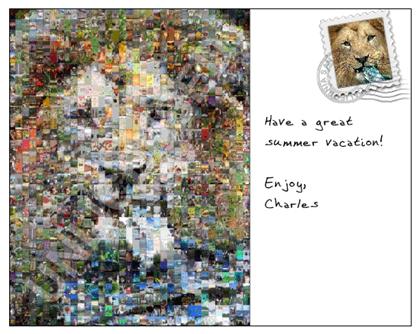How To
Summer Photo Fun
Summer means vacations, and vacations mean taking lots and lots of pictures with your digital camera. No matter how fun it is to take them, it’s even more fun to share them. I’ll cover a few fun ways to share your summer memories. The Mac is great since it comes bundled with iPhoto, which lets you organize and touch up your photos with amazing ease. However, once you have a digital camera you may find yourself buried in photos, and instead of your shoebox being overstuffed with photos, your iPhoto library is bursting at the seams.
It’s too bad iPhoto lets you have only one library, but Brian Webster’s iPhoto Library Manager solves this problem by letting you create more than one photo library with an interface that allows you to “seamlessly” switch between them. So you might create a library for family photos, one for vacations, or whatever you choose. Now that you’ve organized the tons of photos, what are you going to do with them? Obviously you’ll choose a few to share with friends and family, but which ones? How about all of them all at once?
You may remember a few years ago seeing pictures made up of thousands of little pictures were all the rage, often sold under the trade name Photomosaic®. These clever montages were developed by a student at MIT’s Media Lab. Wouldn’t it be great if you could create your own photo montage of your favorite vacation picture, made up of your other vacation pictures? Well, now you can by using Frank M. Midgeley’s MacOSaiX.
With MacOSaix, you choose the picture you want for your montage and then select image sources to provide the individual tiles that make up your picture. You can choose folders from your own computer, or downloaded from Google Images based on keywords, or choose glyphs (which are different characters and fonts chosen at random from your system). Select how detailed you want your picture to be by choosing the number of tiles you want your montage to have. While it is true that the more tiles the better looking the montage, the downside is that it takes longer. Once these options have been chosen, let MacOSaix go at it. It’s a fun process to watch as your image slowly gets made as MacOSaix chooses the best tiles. I found that a combination of local pictures and Google pictures works best.
Now that your vacation is captured all in one picture, what’s next? You can e-mail it to your friends, create an iCard with it if you have .Mac, or post it on a Web site. If you don’t have .Mac, you can use Steve DeKorte’s Postcard to make graphical postcards of your own, even letting you customize the stamp and postmark and type a short message. It’s a simple application, but lots of fun if you want to create personalized postcards for holidays or special occasions.
The great thing about cameras is that they are the most personal piece of technology around. They don’t offer anything that you’re not personally involved in, and that is a really neat thing when you think about all the images and media you can buy today. The pictures you take can truly be priceless—and truly your own.
So it doesn’t seem right that you should choose to use a regular font that everyone else can get when you create your postcard. Fontifier is a service that creates a font of your own handwriting. The service is easy to use. Visit the Web site to download a template and print it out. Using a felt-tipped pen, write down your version of each letter and rescan the template into your Mac. Upload the scan to the Fontifier Web site. You can then preview your new font to decide if you want to purchase it or not.

Take a look at the sample image and you can see everything put together, a MacOSaix photo montage of a lion photo from the AP, in a Postcard. The stamp has the original image so you can compare, and the text of the postcard is in my own personal font.
Have fun with your pictures and have a great summer.
Also in This Series
- Give Alert Sounds a Little Personality · March 2012
- Create Your Own iPhone Ringtones · February 2012
- Create Your Own Homemade Audio Book · December 2011
- Upgrade to Lion Painlessly · August 2011
- Make the Most of TextEdit · July 2011
- Using the Free Disk Utility on Your Mac · May 2011
- Making Use of QuickTime X · March 2011
- Making the Most of What’s Already on Your Mac · February 2011
- Making the Most of What’s Already on Your Mac · January 2011
- Complete Archive
Reader Comments (2)
Add A Comment